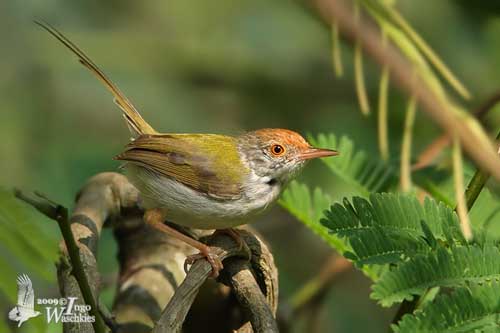
Common Tailorbird
Orthotomus sutorius
Passeriformes Order – Cisticolidae Family
BIOMETRICS:
Length : 12-13 cm
Weight : 6-10 g
DESCRIPTION:
Common Tailorbird is a small bird with long tail often held upright.
Adult male has bright olive-green upperparts. Underparts are paler, creamy buff. Thighs are rufous. Wings are short and rounded. In breeding plumage, central tail feathers growth of some centimetres, about three.
On the head, centre of crown is rufous and face is white. We can see black patches on the neck. Bill is long and down curved. Eyes are pale brown. Legs and feet are pinkish.
Fr: Couturière à longue queue
All : Rotstirn-Schneidervogel
Esp : Sastrecillo Común
Ital : Uccello sarto codalunga
Nd : Langstaart-snijdervogel
Russe : Славка-портниха
Photographers:
Didier Buysse
Vision d’Oiseaux
Jean Michel Fenerole
Photos d’Oiseaux du monde
Ingo Waschkies
Bird Photography
Text by Nicole Bouglouan
Sources :
LES OISEAUX DE THAILANDE par Roland Eve et Anne-Marie Guigue - Times Editions - ISBN: 9812042008
L’ENCYCLOPEDIE MONDIALE DES OISEAUX - Dr Christopher M. Perrins - BORDAS - ISBN: 2040185607
Wikipedia (Wikipedia, The Free Encyclopedia)
Sungei Buloh Wetlands Reserve (Michael Mastaller)

BEHAVIOUR:
Common Tailorbird is very active when foraging and hopping into vegetation of wooded habitat, searching for insects. This bird flicks continuously its tail, often erect. Always active and restless, they are usually seen in pairs.
Common Tailorbird is resident and breeds in its range. It gets its name from the way its nest is built, sewing leaves together with spider webs or fine grass.
This species is well adapted to humans and urban areas which they are rapidly colonising.
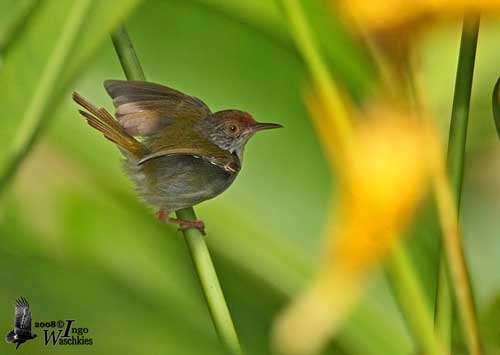
VOICE: SOUNDS BY XENO-CANTO
Common Tailorbird utters a rapid series of monotonous and repeated “chwee-o, chi-up, chee-rup”. It also utters a rapid descending trill including five notes.
HABITAT:
Common Tailorbird lives in deciduous forests, scrublands, mangroves, open woodlands and gardens.
RANGE:
Common Tailorbird is resident, and breeds in South Asia, from Pakistan and India to South China, and Indonesia. It can be found up to 1600 metres of elevation in SW Asia.
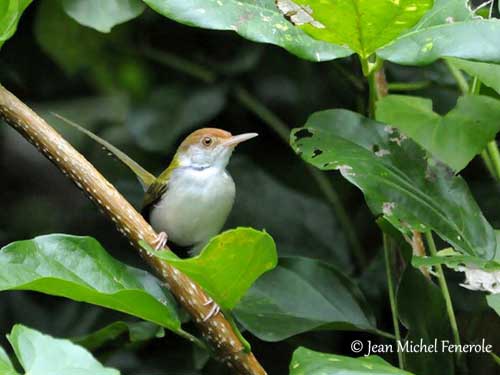
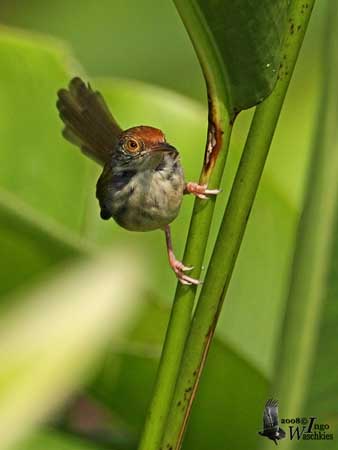
FLIGHT:
Common Tailorbird performs short, quick darting flights.
REPRODUCTION:
Common Tailorbird’s nest is very special and built by female in a broad-leaved plant. Male may escort her when she collects nest materials. Breeding season starts in January, with a peak in February-March, and until June. But it depends on the place.
Female builds the nest, using one or two large green living leaves, in low bush or small tree. She pierces an equal number of holes on each leaf edge, using its pointed bill as a needle. Then, she sews the edges together with spider webs, plant fibres or fine grass. She stitches back and forth through the holes, and joins the leaves’ edges. She leaves an entrance hole at the top.
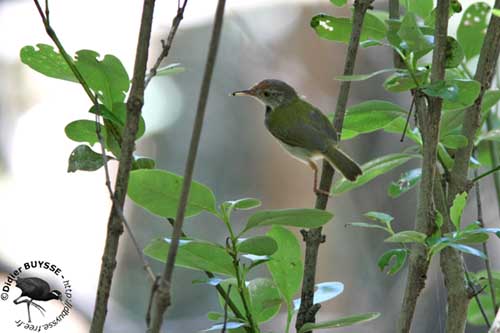
The real nest is built inside this conical shelter. She waves fine strands of grass and forms the cup. Then, this tiny cup is lined with feathers and other soft materials such as plant down. Nest is usually low and well hidden, at about one metre above the ground.
Female lays 2 to 5 pastel blue eggs, speckled with brown. Incubation lasts about 12 days, by female. Both parents feed and raise the chicks. Young fledge at about 24 days of age.
DIET:
Common Tailorbird feeds mainly on insects, adults and larvae. It also consumes small fruits, berries, some nectar and tiny seeds.
PROTECTION / THREATS / STATUS:
Common Tailorbird is well adapted to humans. The species is common and widespread in its range, and not threatened.
